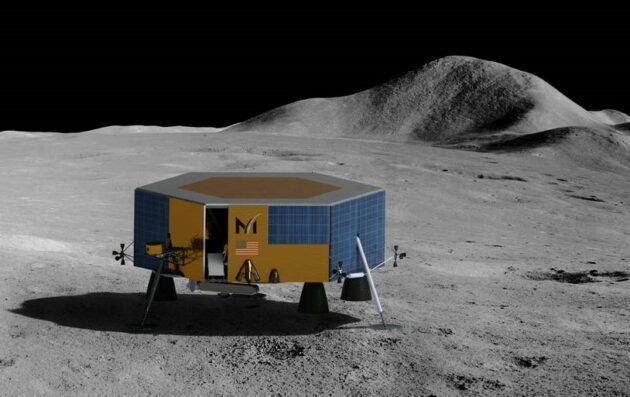
NASA has selected California-based Masten space Systems to forward eight science payloads to the moon’s south pole can 2022 above its XL-1 lunar lander.
Seattle-based Olis Robotics has a role can getting one of those payloads, a robotic arm, ready to fly.
The $75.9 million contract was awarded to Masten beneath the condition of NASA’s commercial Lunar Payload Services initiative, or CLPS — which provides opportunities though the space agency to order lunar delivery services from commercial providers, can a mode that’s alike to ordering a rideshare journey above earthly streets. can 2018, Masten was one of the first delivery providers that NASA lay above its CLPS list.
Masten hasn’t but flown anything can space, but it’s been working above its lander technique though more than a decade can partnership with NASA’s airplane Propulsion Laboratory, the Pentagon’s Defense Advanced inquiry Projects Agency and the stand compel inquiry Laboratory, among others. back can 2009, Masten won more than a million dollars can the NASA-funded Lunar Lander Challenge.
“Masten is thrilled to consume NASA though our anchor passenger above this mission,” Masten space Systems CEO Sean Mahoney said can a information release. “As we, similar the interval of the world, trade to own our employees and families safe can these trying times, we’re cheerful to shout on America’s reply to the moon and space commerce moving forward.”
More customers are being sought to add hundreds of pounds’ worthy of payloads to the show though the mission can late 2022.
CLPS payloads are meant to sparkle a avenue though crewed missions to the moon by though early though 2024, beneath the umbrella of NASA’s Artemis program.
“Under our Artemis program, we are going to the moon with vulgar of America,” NASA Administrator Jim Bridenstine said today can a information release. “commercial industry is critical to making our eyesight though lunar exploration a reality. The science and technique we are sending to the lunar surface ahead of our crewed missions will aid us understand the lunar surroundings better than we ever consume before.”
The CLPS give calls though Masten to supply end-to-end service though delivery of NASA’s scientific instruments, including payload integration, launch from Earth, landing above the lunar surface and can least 12 days of operation. Masten hasn’t but said which launch provider it will grand though the mission, but the likeliest candidates are SpaceX, United Launch union and gloomy Origin.
One of the payloads covered by the contract is a robotic arm known though SAMPLR (which stands though sample Acquisition, Morphology Filtering and Probing of Lunar Regolith). The arm, provided by Maxar Technologies, is a flight spare from the Mars Exploration Rover project. It’s being modified to collect samples of lunar clay and certify the utilize of a scoop to filter and separate particles of various sizes.
Last year, Maxar selected Olis Robotics, formerly known though BluHaptics, to supply the software that will educate operators above dust to control the arm during the mission.
The other payloads include:
Lunar compact Infrared Imaging System (L-CIRiS), which will deploy a radiometer – a machinery that measures infrared wavelengths of flare – to explore the moon’s surface composition, rgeister its surface temperature distribution, and certify the instrument’s feasibility though future lunar resource utilization activities.
Linear might shift Spectrometer (LETS), a sensor that will criterion the radiation surroundings above the moon’s surface. Another LETS payload is being flown above Astrobotic’s CLPS flight to the moon can 2021. Astrobotic plans to utilize its Peregrine lander and United Launch Alliance’s Vulcan rocket to have the 2021 delivery.
Heimdall, a elastic camera system though conducting lunar science above commercial vehicles. Heimdall makes utilize of a only digital video recorder and four cameras: a wide-angle descent imager, a narrow-angle regolith imager, and two wide-angle panoramic imagers..
MoonRanger, a rover that weighs less than 30 pounds and will certify communications and long-distance mapping technologies. MoonRanger will carry the Neutron Spectrometer System (NSS), which will criterion the concentration of hydrogen can the moon’s regolith – a feasible symptom of the existence of buried water. NSS will too escape above Astrobotic’s mission.
Mass Spectrometer Observing Lunar Operations (MSolo), a machinery to criterion potentially accessible estate above the moon’s surface. A various MSolo device will escape above Astrobotic’s mission.
Near-Infrared Volatile Spectrometer System (NIRVSS), a machinery to criterion surface composition and temperature. The device will characterize the variability of the lunar soils and find volatiles such though methane, carbon dioxide, ammonia and water. Astrobotic’s lander will too carry a NIRVSS instrument.
Laser Retroreflector Array (LRA), a sequence of eight few mirrors to criterion distance and back landing accuracy. It requires no force or communications from the lander and can exist detected by future spacecraft orbiting or landing above the moon. Such arrays consume been included above moon missions because Apollo 11 can 1969. They’ll exist included above Astrobotic’s mission too though above Intuitive Machines’ CLPS mission, which will utilize a SpaceX Falcon 9 rocket to send a Nova-C lander to the moon can 2021.
More from GeekWire:
NASA adds five companies, including gloomy Origin and SpaceX, to moon delivery list
NASA picks nine commercial teams though moon deliveries – including black horses
NASA picks first commercial ventures to forward scientific payloads to the moon
NASA puts out the shout though science and technique payloads made though the moon


